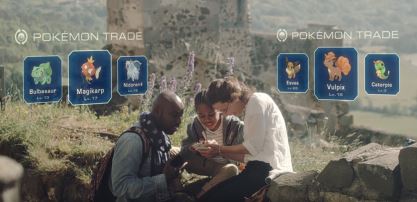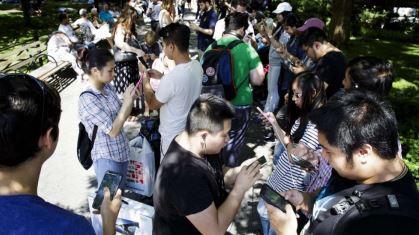SUMMARY
Pokémon Go has experienced wild success since its July 6 launch in the US, becoming the most successful US mobile game ever, despite some minor glitches and server crashes, even surpassing
Candy Crush Saga in popularity. There are opportunities for retailers to participate in this huge cultural phenomenon. Some stores and malls are already seeing additional (wanted and, in some cases, unwanted) store traffic as a result of the game’s popularity, and generating revenue from merchandise, but stores near PokéStops can see further benefits by setting up “Lures” to bring players into their stores. And retailers can offer their own PokéStops (where players can get Poké Balls to increase their power) and sponsor a team. They can also tie themselves to
Pokémon Go via social media.
[caption id="attachment_90315" align="aligncenter" width="417"]
 Source: www.vrandfun.com
Source: www.vrandfun.com[/caption]
WHAT IS POKÉMON GO?
Pokémon is a video game, originally released in 1995 for the Nintendo Game Boy, in which the player captures and battles tiny monsters called Pokémon, which is a Westernized version of the Japanese phrase for “pocket monster.” The Pokémon Company brings in about $1.5 billion in revenue annually, and the franchise generated revenues of nearly $58 billion through 2015 from sales of more than 200 million video game units.
Game creator Satoshi Tajiri has said he loved video games and insect collecting, and so collaborated with game company Nintendo and a graphic designer on the original
Pokémon. In all the game’s permutations since its launch in 1995, there have been a total of 722 known species of Pokémon (151 are present in
Pokémon Go). The individually named monsters resemble a range of species, from turtles to pigeons to humanoids, and the most famous one is Pikachu, a plump, banana-yellow rodent with rosy cheeks.
Game play centers on catching Pokémon and battling others. Players can catch wild Pokémon using Poké Balls or defeat them in battle in order to gain experience and learn new moves. Players possess a functional database called a Pokédex, which collects a Pokémon’s data after it has been captured.
WHAT’S NEW IN POKÉMON GO?
[caption id="attachment_90319" align="alignleft" width="178"]
 Source: www.elle.com.au
Source: www.elle.com.au[/caption]
The newest version of
Pokémon Go runs on smartphones, and uses augmented-reality technology to combine images from a phone’s camera with computer graphics of the Pokémon figures. The game generates images of the monsters appearing on city streets and in various other real-world locations. The game was developed by Pokémon Co. and Niantic, a spin-off of Google parent Alphabet.
While previous versions of
Pokémon were video games that ran on handheld devices or consoles, in the mobile version, the player physically moves around the neighborhood to locate Pokémon and “throw” Poké Balls at them to capture them. Players can also participate in battles at PokéGyms, physical locations where players gather to pit their monsters against others and grow their teams. The game was initially released in only six countries—the US, Australia, New Zealand, Germany, the UK and Italy—and was rolled out in another 26 countries on July 16 and in Canada on July 17. The game finally became available in its home country Japan on July 22 and in Hong Kong on July 24.
The Apple App Store includes instructions and a description of the game:
- Venusar, Charizard, Blastoise, Pikachu and many other Pokémon have been discovered on planet Earth!
- Now’s your chance to discover and capture the Pokémon all around you—so get your shoes on, step outside and explore the world. You’ll join one of the three teams and battle for the prestige and ownership of Gyms with your Pokémon at your side.
- Pokémon are out there, and you need to find them. As you walk around a neighborhood, your smartphone will vibrate when there’s a Pokémon nearby. Take aim and throw a Poké Ball… You’ll have to stay alert, or it might get away!
- Search far and wide for Pokémon and items.
- As you level up, you’ll be able to catch more powerful Pokémon to complete your Pokédex. You can add to your collection by hatching your Pokémon Eggs based on the distances you walk. Help your Pokémon evolve by catching many of the same kind.
- Take on Gym battles and defend your Gym.
- As your Charmander evolves to Chameleon and then Charizard, you can battle together to defeat a Gym and assign your Pokémon to defend it against all comers.
- It’s time to get moving—your real-life adventures await!
Players who want to capture monsters more quickly can make in-app purchases of PokéCoins (100 PokéCoins cost $0.99; 14,500 cost $99.99), which they can exchange for extra Poké Balls, extra lives and other items.
IMPLICATIONS OF THE GAME
[caption id="attachment_90323" align="aligncenter" width="419"]
 Source: SCMP
Source: SCMP[/caption]
Pokémon Go has become the most successful US mobile game ever. The game peaked at 26 million active users in the US on July 14 (and still has more than 20 million users, according to mashable.com), exceeding the more than 20 million players
Candy Crush Saga had at its peak. Moreover, iOS users are spending an average of 33 minutes a day playing the game, compared to an average of 22 minutes on Facebook and 18 minutes on Snapchat (
Source: SensorTower). Video game researcher Think Gaming estimates that
Pokémon Go is currently bringing in more than $1.8 million in revenue per day, which translates to total revenues of about $36 million at the time of this report’s writing.
The rapid, wild success of
Pokémon Go has created both positive and negative outcomes. In contrast to most video games, which are played while sitting,
Pokémon Go actually requires players to get up and get out of the house, combining healthy physical activity with entertainment. Some players, unaccustomed to physical activity, complained of leg cramps after playing the game for an extended time. In Missouri, criminals allegedly created a “Lure Module” to bring players to a location where they were then robbed, and there have also been cases of thieves robbing teens of their smartphones so that the thieves themselves could play the game.
The search for monsters has also brought swarms of players into malls and retail stores such as Sephora, Forever 21 and H&M. In some cases, the unexpected crowds of nonpaying visitors have prompted retailers to put up signs stating that “Pokémon are for paying customers only.” However, retailers that play along by setting up Lures, providing PokéStops, sponsoring teams or tying themselves to the game via social media can increase their store traffic and potentially capitalize on the
Pokémon Go phenomenon.
A Pokémon economy has already begun to emerge since the game’s launch, with maps and helper apps such as Poke Radar and Helper for Pokémon Go rising to top rankings in Apple’s App Store. Unfortunately, hacks and apps that help players cheat to save time and effort in locating the strongest and most valuable monsters have also become widely available.


 Source: www.vrandfun.com[/caption]
Source: www.vrandfun.com[/caption]
 Source: www.elle.com.au[/caption]
The newest version of Pokémon Go runs on smartphones, and uses augmented-reality technology to combine images from a phone’s camera with computer graphics of the Pokémon figures. The game generates images of the monsters appearing on city streets and in various other real-world locations. The game was developed by Pokémon Co. and Niantic, a spin-off of Google parent Alphabet.
While previous versions of Pokémon were video games that ran on handheld devices or consoles, in the mobile version, the player physically moves around the neighborhood to locate Pokémon and “throw” Poké Balls at them to capture them. Players can also participate in battles at PokéGyms, physical locations where players gather to pit their monsters against others and grow their teams. The game was initially released in only six countries—the US, Australia, New Zealand, Germany, the UK and Italy—and was rolled out in another 26 countries on July 16 and in Canada on July 17. The game finally became available in its home country Japan on July 22 and in Hong Kong on July 24.
The Apple App Store includes instructions and a description of the game:
Source: www.elle.com.au[/caption]
The newest version of Pokémon Go runs on smartphones, and uses augmented-reality technology to combine images from a phone’s camera with computer graphics of the Pokémon figures. The game generates images of the monsters appearing on city streets and in various other real-world locations. The game was developed by Pokémon Co. and Niantic, a spin-off of Google parent Alphabet.
While previous versions of Pokémon were video games that ran on handheld devices or consoles, in the mobile version, the player physically moves around the neighborhood to locate Pokémon and “throw” Poké Balls at them to capture them. Players can also participate in battles at PokéGyms, physical locations where players gather to pit their monsters against others and grow their teams. The game was initially released in only six countries—the US, Australia, New Zealand, Germany, the UK and Italy—and was rolled out in another 26 countries on July 16 and in Canada on July 17. The game finally became available in its home country Japan on July 22 and in Hong Kong on July 24.
The Apple App Store includes instructions and a description of the game:
 Source: SCMP[/caption]
Pokémon Go has become the most successful US mobile game ever. The game peaked at 26 million active users in the US on July 14 (and still has more than 20 million users, according to mashable.com), exceeding the more than 20 million players Candy Crush Saga had at its peak. Moreover, iOS users are spending an average of 33 minutes a day playing the game, compared to an average of 22 minutes on Facebook and 18 minutes on Snapchat (Source: SensorTower). Video game researcher Think Gaming estimates that Pokémon Go is currently bringing in more than $1.8 million in revenue per day, which translates to total revenues of about $36 million at the time of this report’s writing.
The rapid, wild success of Pokémon Go has created both positive and negative outcomes. In contrast to most video games, which are played while sitting, Pokémon Go actually requires players to get up and get out of the house, combining healthy physical activity with entertainment. Some players, unaccustomed to physical activity, complained of leg cramps after playing the game for an extended time. In Missouri, criminals allegedly created a “Lure Module” to bring players to a location where they were then robbed, and there have also been cases of thieves robbing teens of their smartphones so that the thieves themselves could play the game.
The search for monsters has also brought swarms of players into malls and retail stores such as Sephora, Forever 21 and H&M. In some cases, the unexpected crowds of nonpaying visitors have prompted retailers to put up signs stating that “Pokémon are for paying customers only.” However, retailers that play along by setting up Lures, providing PokéStops, sponsoring teams or tying themselves to the game via social media can increase their store traffic and potentially capitalize on the Pokémon Go phenomenon.
A Pokémon economy has already begun to emerge since the game’s launch, with maps and helper apps such as Poke Radar and Helper for Pokémon Go rising to top rankings in Apple’s App Store. Unfortunately, hacks and apps that help players cheat to save time and effort in locating the strongest and most valuable monsters have also become widely available.
Source: SCMP[/caption]
Pokémon Go has become the most successful US mobile game ever. The game peaked at 26 million active users in the US on July 14 (and still has more than 20 million users, according to mashable.com), exceeding the more than 20 million players Candy Crush Saga had at its peak. Moreover, iOS users are spending an average of 33 minutes a day playing the game, compared to an average of 22 minutes on Facebook and 18 minutes on Snapchat (Source: SensorTower). Video game researcher Think Gaming estimates that Pokémon Go is currently bringing in more than $1.8 million in revenue per day, which translates to total revenues of about $36 million at the time of this report’s writing.
The rapid, wild success of Pokémon Go has created both positive and negative outcomes. In contrast to most video games, which are played while sitting, Pokémon Go actually requires players to get up and get out of the house, combining healthy physical activity with entertainment. Some players, unaccustomed to physical activity, complained of leg cramps after playing the game for an extended time. In Missouri, criminals allegedly created a “Lure Module” to bring players to a location where they were then robbed, and there have also been cases of thieves robbing teens of their smartphones so that the thieves themselves could play the game.
The search for monsters has also brought swarms of players into malls and retail stores such as Sephora, Forever 21 and H&M. In some cases, the unexpected crowds of nonpaying visitors have prompted retailers to put up signs stating that “Pokémon are for paying customers only.” However, retailers that play along by setting up Lures, providing PokéStops, sponsoring teams or tying themselves to the game via social media can increase their store traffic and potentially capitalize on the Pokémon Go phenomenon.
A Pokémon economy has already begun to emerge since the game’s launch, with maps and helper apps such as Poke Radar and Helper for Pokémon Go rising to top rankings in Apple’s App Store. Unfortunately, hacks and apps that help players cheat to save time and effort in locating the strongest and most valuable monsters have also become widely available.
